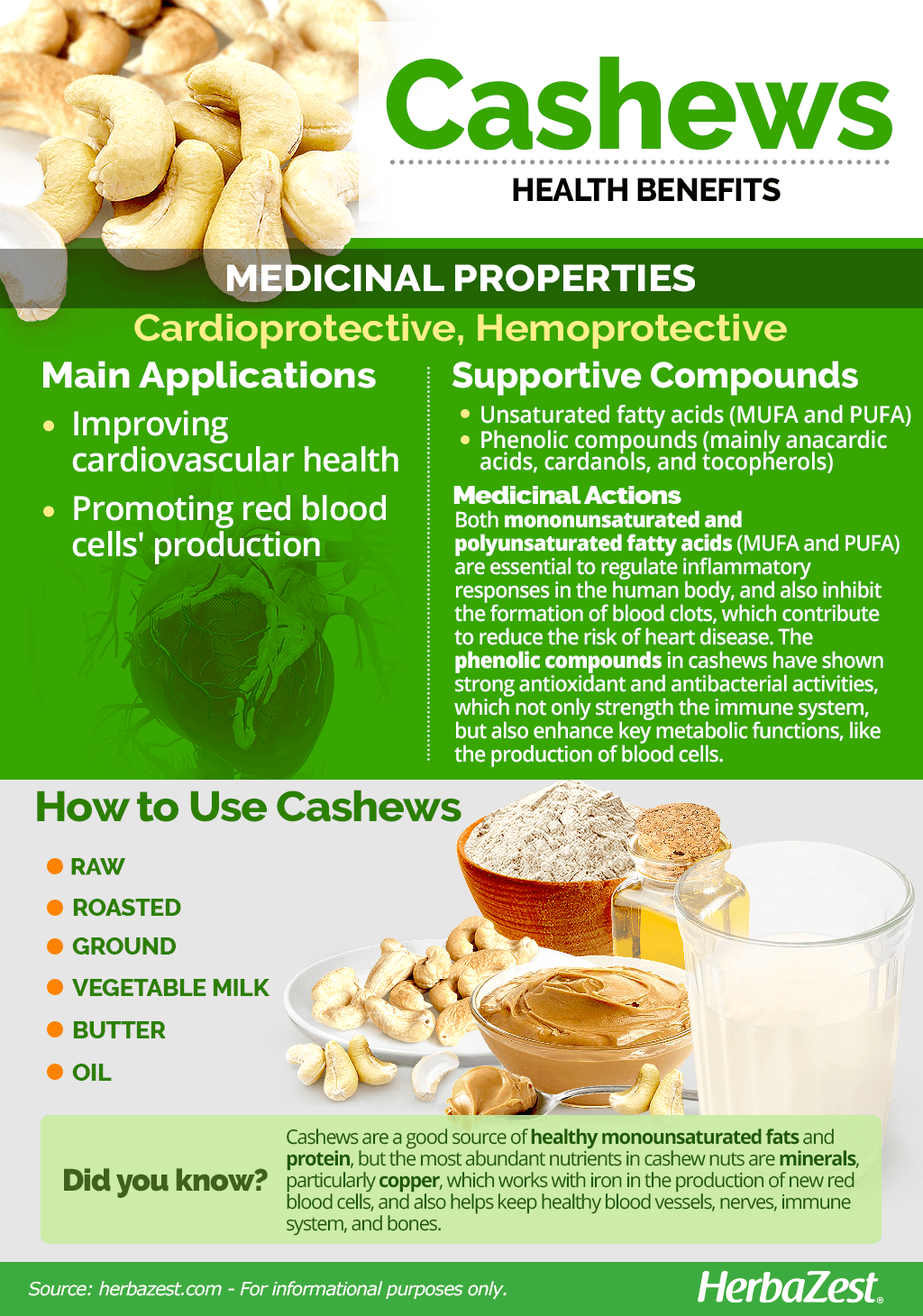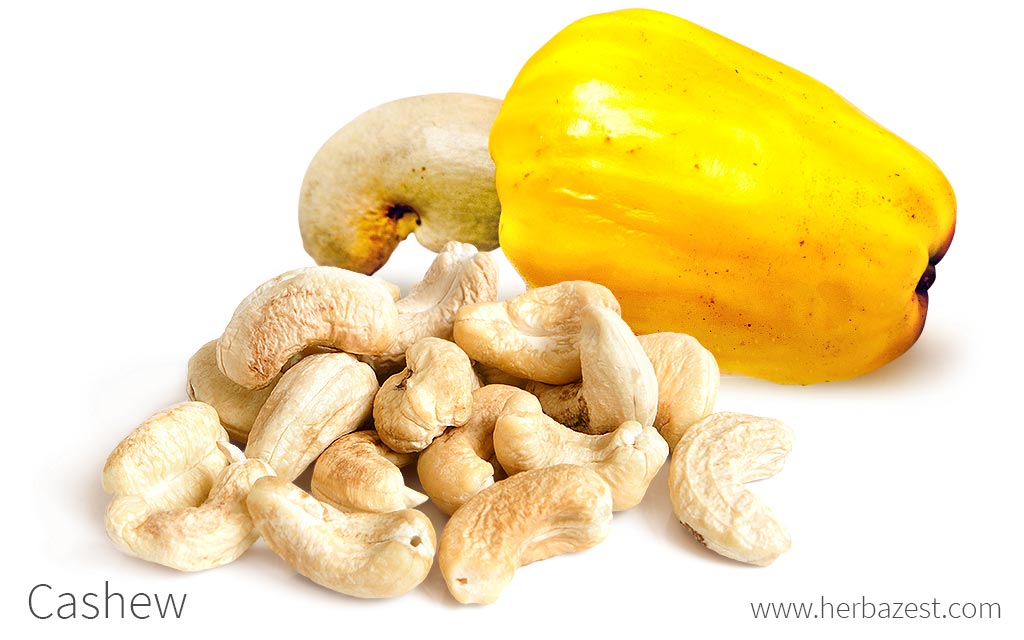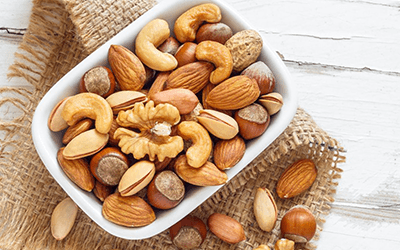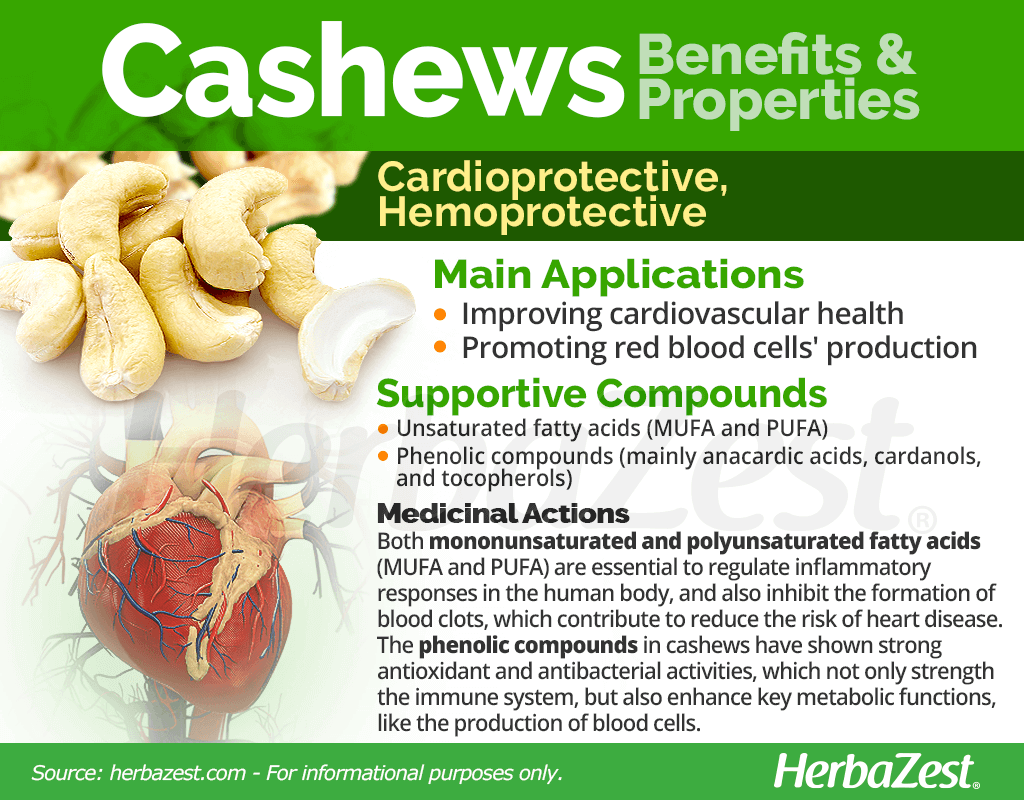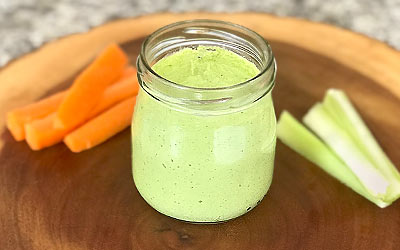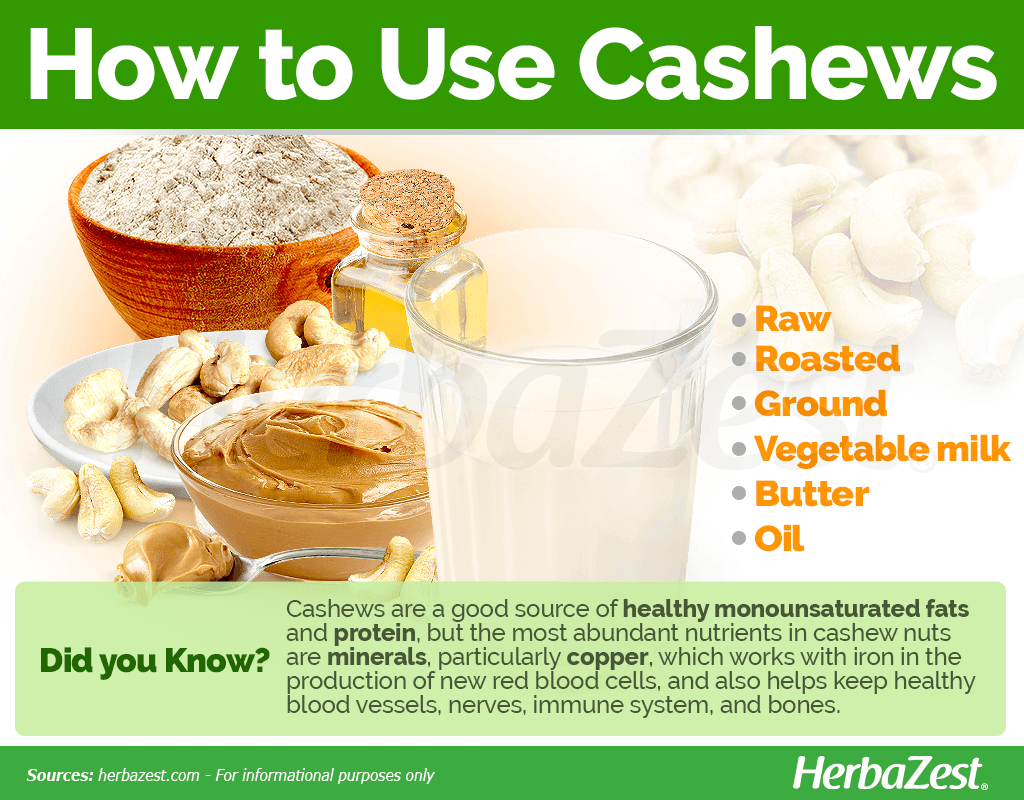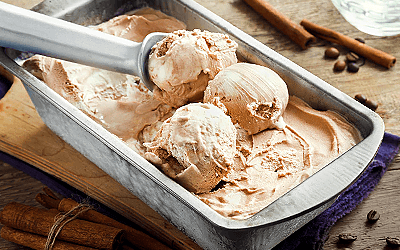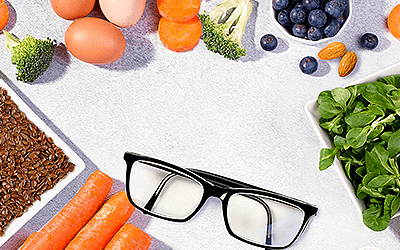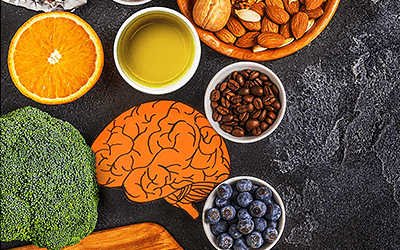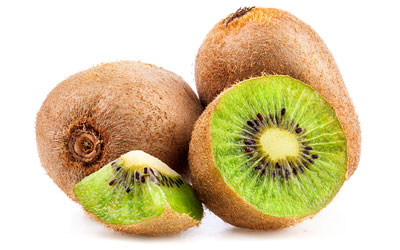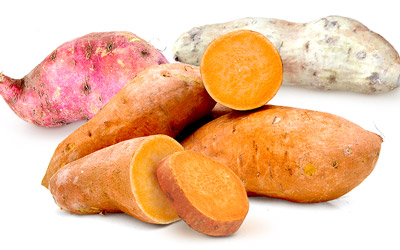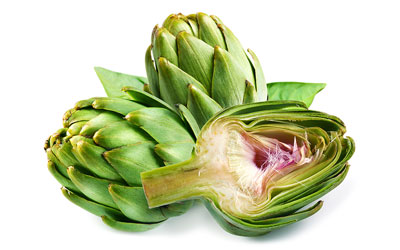Although native to northeastern Brazil, cashews, also known as cashew nuts, kidney nuts, and kajun, are now widely grown in tropical regions of the world. Cashew trees produce a seed that comes with a fruit attached, two valuable products considered of high economic value to many countries. The fruit of cashew tree, otherwise known as the cashew apple, is considered an accessory to the nut, but it can be eaten raw, used to make tropical drinks, and fermented for alcohol.
Cashew Medicinal Properties
Health Benefits of Cashew Nuts
Cashew nuts not only have an impressive nutritional profile, but they also boast medicinal properties. The most popular health benefits of cashews include:
Improving cardiovascular health. Cashew nuts can reduce triglycerides and increase blood circulation, thus lowering the risk of coronary heart disease.
Promoting red blood cells' production. Cashews have been shown to increase the generation of blood cells, which are vital to all body functions, from brain and lungs, to bones and the immune system.
Additionally, the reduction of the frequency and intensity of migraines and diarrhea is one of the many benefits of eating cashews every day.
In its native areas, different parts of the cashew tree have been traditionally employed in folk medicine. The cashew leaves are used for treating diabetes mellitus, and promising studies have shown they actually may be effective reducing blood sugar levels.
The tea of cashew bark, on the other hand, is a common remedy for wounds, high blood pressure, inflammation, and bacterial infections, as well as for relieving pain and enhance libido, among many other applications backed up by little or no scientific evidence.
How It Works
Several bioactive substances have been identified in cashews, chiefly unsaturated fatty acids and phenolic compounds.
Cashews are particularly rich in monounsaturated fatty acids (MUFA), which can lower LDL cholesterol levels in blood - making them a healthy snack.1
Both mononunsaturated and polyunsaturated fatty acids (MUFA and PUFA) are essential for prostaglandine metabolism, which regulate inflammatory responses in the human body, and also inhibit the formation of blood clots.
Numerous studies have shown the benefits of eating cashews daily, along with other tree nuts, as a part of a diet low in saturated fat and cholesterol, since they can contribute to reduce the risk of heart disease.
Antioxidants are widespread across the plant kingdom and play an essential role in human health, protecting the cells from the damage caused by free radicals. The phenolic compounds in cashews, mainly anacardic acids, cardanols, and tocopherols, have shown strong antioxidant and antibacterial activities2,3, which not only strength the immune system against harmful pathogens, but also enhance key metabolic functions, like the production of blood cells, which are responsible for carrying oxygen through the body.4
Cardioprotective properties can also be found in herbs like olive and sacha inchi, whereas vanilla and garlic are thought to protect the integrity of blood cells.
Cashews Cautions
While highly beneficial for most people, the proteins in cashew nuts can induce allergic reactions in sensitive individuals, from contact dermatitis to anaphylaxis. Those prone to nut allergy should avoid consuming cashews.
Although only cashew kernels are normally sold, upon harvesting the seed is surrounded by a shell which contains a reddish-brown, viscous, oily liquid that is highly toxic and can irritate the skin upon touch. Removal of the kernel from raw cashew nuts requires special precautions and procedures. The sap from the wood, leaves, and flowers may also cause dermatitis and the smoke from burning any part of the tree is poisonous.
Cashew nuts also contain small amounts of oxalate, which can lead to the formation of kidney stones if ingested in excess. People who already have kidney stones or kidney disease should avoid over consumption.
- Medicinal action Cardioprotective, Hemoprotective
- Key constituents Unsaturated fatty acids (MUFA and PUFA) and phenolic compounds (mainly anacardic acids, cardanols, and tocopherols)
- Ways to use Food, Juiced, Powder, Essential oil
- Medicinal rating (3) Reasonably useful plant
- Safety ranking Safe
Cashew Nutrition
Cashew nuts are high in calories, but lower in fat when compared to most other nuts. Cashews are also a good source of healthy monounsaturated fats and protein, but the most abundant nutrients in cashew nuts are minerals, which help protect nerve health, promote healthy bones, reduce migraines, and lower the risk of coronary heart disease.
The most important mineral present in cashew nuts is copper, which works with iron in the production of new red blood cells, and also helps keep healthy blood vessels, nerves, immune system, and bones.
Magnesium is also present in good amounts in cashews, and helps with the formation of connective tissue, bones, blood clotting, and sex hormones. It also plays a role in fat and carbohydrate metabolism, calcium absorption, and blood sugar regulation.
On the other hand, the manganese in cashew nuts aids with protein synthesis, muscle and nerve function, blood glucose control, and blood pressure, being also required for energy production, whereas zinc is not only required for immunity, but also plays a role in wound healing and the breakdown of carbohydrates.
Other minerals, like phosphorus, potassium, selenium, and iron are also present in smaller amounts, but all of them contribute to overall health as a part of a balanced diet.
The fruit of the cashew tree, commonly known as "cashew apple," was widely consumed before the nuts became popular and contains five times more vitamin C (ascorbic acid) than an orange, as well as more calcium, iron, and vitamin B1 (thiamine) than avocados or bananas.
20 grams of raw cashew nuts provide 111 calories, as well as 7% of protein's daily requirements for adults.
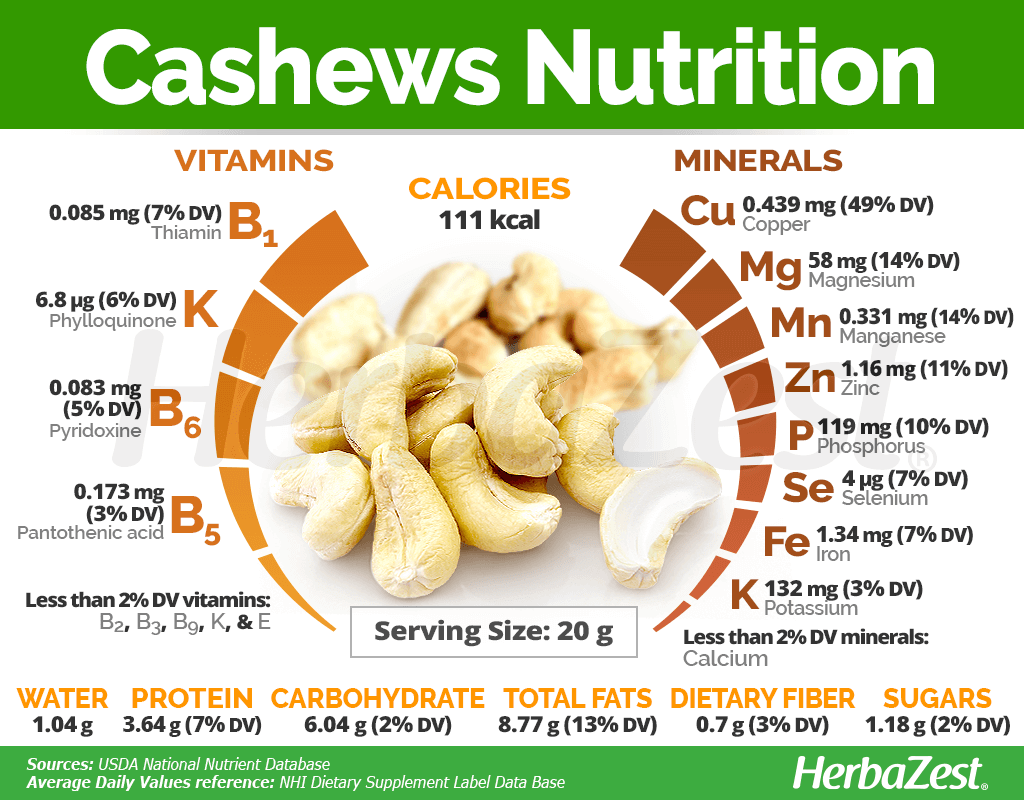
How to Consume Cashew
Cashew nuts are consumed in their natural forms, most commonly raw or roasted, and they make for a delicious and healthy snack.
The cashew fruit, or cashew apple, is also edible and beneficial; however, it can't be transported and is consumed typically as a juice within its native areas. Cashew apple juice, without tannins' removal, is prescribed as a remedy for sore throat and chronic dysentery in Cuba and Brazil.
Natural Forms
Raw. In their natural state, cashews make a great snack, and due to their mild, agreeable flavor they can be used in a wide variety of sweet and savory recipes.
Roasted. When roasted, cashews increase their natural antioxidant properties and are often mixed with other nuts as a snack.
Ground. Once dried and ground into a fine powder, cashews make a great gluten free alternative and can be added to a myriad of recipes, including, smoothies, baking goods, and much more.
Vegetable milk. Like other nuts, a highly nutritious vegetable juice can be obtained from cashews, and it makes a great cow milk substitute in any recipes that call for it.
Butter. Just like peanuts and almonds, cashews can be blended into a creamy paste and be consumed with toasts, or be used as an ingredient in sweet or savory dishes.
Oil. The oil of cashew kernels is rich in antioxidants and a great source of unsaturated fatty acids. It can be used in culinary preparations, taken by the spoon for heart health, or applied topically to repair dry hair and chapped skin.
- Edible parts Fruit, Seed
- Edible uses Oil, Dairy substitute
- Taste Sweet
Growing
Because of their specific climate requirements, cashews are only produced in tropical countries. Even for those gardeners living in cashews' friendly zones, cultivation may be a challenge, since the cashew nut tree needs plenty of room to grown, and it will take few years in giving its delicious fruits.
Growing Guidelines
The cashew plant can be grown straight from the nut still inside its shell. They do best in well-drained, slightly acidic soils.
As it grows, the cashew nut tree should be kept under an average temperature of 80°F (27°C), since it is unable to withstand any temperatures below 50°F (10°C).
The cashew tree can tolerate drought conditions, and when grown from seed, they germinate rather quickly and vigorously.
Cashew seeds should be planted straight into the ground and the soil should be kept moist, as they will begin to sprout within a few days.
The cashew nut tree will start producing fruit or seeds three years after being planted; however, economically-viable harvests only begin after eight years.
- Life cycle Perennial
- Harvested parts Seeds, Fruit
- Light requirements Full sun, Full sun with reflected heat
- Soil pH 6.1 – 6.5 (Slightly acidic)
- Growing habitat Subtropical regions, Tropical rainforests
Additional Information
Plant Biology
Cashew trees grow to be 32 feet (10 m) tall. They tend towards a short, irregular shaped trunk, and boast a large evergreen canopy. A pear-shaped fruit, called the cashew apple, hangs about 2 - 4 inches (5 - 10 cm) long and contains a strong, sweet smell and taste. A kidney-shaped drupe hangs from the cashew apple, containing a seed, or cashew nut.
Classification
The cashew tree (Anacardium occidentale) belongs to the Anacardiaceae family, which encompasses 600 species across 80 genera, mainly in tropical, subtropical, and temperate areas of the world. Other members of this family that produce edible fruit are mango (Mangifera indica) and pistachio (Pistacia vera).
Related Species of Cashew Tree
There are no known varieties or subspecies of Anacardium occidentale. However, notable related species of cashew are the wild cashew (Anacardium excelsium) and giant cashew, also known as "caja acu" (Anacardium gigantium). Also significant is Oriental anacardium, or Semecarpus anacardium, which closely resembles cashews and is also a member of the Anacardiaceae family.
The largest living cashew tree can be found in Brazil, covering over 81,000 square feet (24,690 m2) of land.
Historical Information
Discovered by Portuguese explorers in Brazil, cashews were brought to India and Mozambique in the 16th century. From there, the species quickly spread to other parts of East Africa and Angola, as well as throughout southeastern Asia and northern Australia.
Spanish explorers are thought to be the ones that introduced the plant to Central America and the Caribbean basin. However, it took until the early part of the 20th century for cashews to be imported to the United States.
Nowadays, the cashew nut is an important item of commerce; however, in the past the cashew apple was of primary interest, not the nut. There are areas of the Caribbean, South and Central America and East Africa, where trees are still grown solely for local cashew apple consumption.
Economic Data
India led the production of cashews in 2015-2016 with 172,719 metric tons, which represented the 23% of global production, followed by the Ivory Coast (171,111 MT, 23%) and Vietnam (113,095 MT, 15%).
Global production of cashews in 2015-2016 reached 738,861 metric tons, an increase of 3% from the previous season. East and West Africa are exporting almost all their production of in-shell raw cashew nuts to India, Vietnam, and Brazil to be shelled and processed there.
Other Uses
Fungicide. Cashew nuts essential oil is often used in fungicides and for anti-termite treatment.
Additive. It has also been used as an additive to brake fluid, diesel engine fuel alternatives, and lubricants.
Fuel. Studies conducted in India showed that cashew kernels have potential uses as fuel for thermal energy supply.
Industrial. The liquid extracted from the kernels is used to manufacture many industrial products, such as insulating varnishes, oil-and-acid-proof cold setting cements, and flooring.
- Other uses Fuel, Fungicide
Sources
- Biotechnology and Applied Biochemistry, Cashew-tree (Anacardium occidentale L.) exudate gum: a novel bioligand tool. 2002
- Drug Development Research, Gastroprotective properties of cashew gum, a complex heteropolysaccharide of Anacardium occidentale, in naproxen-induced gastrointestinal damage in rats, 2015
- Encyclopedia of Food and Health, pp. 683-686
- Integrated Production Practices of Cashew in Asia, 11. CASHEW NUT NUTRITIONAL ASPECTS
- International Journal of Molecular Sciences, Potential Biological Applications of Bio-Based Anacardic Acids and Their Derivatives, 2015
- International Nut and Dried Fruit Council, Nuts & Dried Fruits, Global Statistical Review 2015/2016
- ISRN Renewable Energy, Cashew Nut Shell Waste: Availability in Small-Scale Cashew Processing Industries and Its Fuel Properties for Gasification, 2011
- Journal of the International Society of Sports Nutrition, Cashew apple juice supplementation enhanced fat utilization during high-intensity exercise in trained and untrained men, 2013
- Purdue University, Cashew Apple, Anacardium Occidentale L.
- The 150 Healthiest Foods on Earth, p. 169
- The Encyclopedia of Healing Foods, pp. 414-415
- Transport Information Services - Germany, Cashew nuts, cashew kernels
- Tree Nuts: Composition, Phytochemicals, and Health Effects, pp. 157-166
- University of Florida, Cashew-Apple Fruit Growing in the Florida Home Landscape
- USDA Nutrient Database, Nuts, cashew nuts, dry roasted, without salt added
Footnotes:
- Food Science & Nutrition. (2016). Nutritional composition of raw fresh cashew (Anacardium occidentale L.) kernels from different origin. Retrieved August 18, 2023, from: https://www.ncbi.nlm.nih.gov/pmc/articles/PMC4779481/
- Journal of Agricultural and Food Chemistry. (2011). Effect of roasting on phenolic content and antioxidant activities of whole cashew nuts, kernels, and testa. Retrieved August 18, 2023, from: https://pubmed.ncbi.nlm.nih.gov/21438525/
- International Journal of ChemTech Research. (2009). Antimicrobial screening of different extract of Anacardium occidentale Linn. Leaves. Retrieved August 18, 2023, from: https://www.cabdirect.org/cabdirect/abstract/20103054117
- Journal of Nutrition and Metabolism. (2020). Effects of Cashew Nut (Anacardium occidentale L.) Seed Flour in Moderately Malnourished Children: Randomized Clinical Trial. Retrieved August 18, 2023, from: https://www.ncbi.nlm.nih.gov/pmc/articles/PMC7222489/
